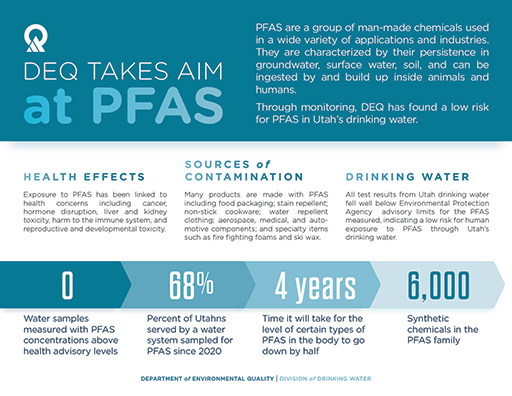On Valentine’s Day, EPA announced the first-ever comprehensive national action plan to address contamination from perfluoroalkyl and polyfluoroalkyl substances referred to as PFAS. This PFAS action plan identifies short-term solutions and long-term strategies for addressing PFAS pollution. This plan provides tools and technologies to states and local communities to aid in providing safer drinking water and help address PFAS at the source—even before it gets into the drinking water.

Perfluoroalkyl substances are a group of more than 4,000 very stable synthetic chemicals. Various commercial applications have used PFAS for years because of their unique ability to repel oil and water. The most commonly found, and best studied, PFAS are perfluorooctanoic acid (PFOA) and perfluorooctanesulfonic acid (PFOS). These two compounds are persistent in the environment and are often referred to as “forever chemicals.”
PFAS chemicals pose a number of potential human health risks. At lower concentrations relative to many other chemicals, they can cause increased risks of cancer, kidney disease, thyroid conditions and auto-immune disorders. The chemicals can also increase cholesterol and possibly cause infertility.
The unique chemical properties of PFAS allow the chemical to migrate throughout the environment contaminating soil, groundwater, and surface water. Scientists regularly find PFAS long distances from the locations where they originated.
Most forms of PFAS are no longer manufactured in the US and others were voluntarily phased out. They are, however, currently found in imported products. In addition, PFAS compounds are still in use in older products.
EPA is moving forward with several important actions, including the maximum contaminant level (MCL) process. This will help affected communities better monitor, detect and address PFAS.
The Action Plan addresses six points
- Regulatory action: By the end of 2019, EPA will propose a regulatory determination, which is the next step in the Safe Drinking Water Act process for establishing an MCL.
- Cleanup: EPA has already begun the regulatory development process for listing PFOA and PFOS as hazardous substances and will issue interim groundwater cleanup recommendations for sites contaminated with PFOA and PFOS. This important work will provide additional tools to help states and communities address existing contamination and enhance the ability to hold responsible parties accountable.
- Enforcement: EPA will use available enforcement tools to address PFAS exposure in the environment and assist states in enforcement activities.
- Monitoring: EPA will propose to include PFAS in nationwide drinking water monitoring under the next Unregulated Contaminant Monitoring Program. The agency will also consider PFAS chemicals for listing in the Toxic Release Inventory to help the agency identify where these chemicals are being released.
- Research: EPA will develop new analytical methods so more PFAS chemicals can be detected in drinking water, soil and groundwater. These efforts will improve Utah DEQ’s ability to monitor and assess potential risks.
- Risk Communications: EPA will work across the agency and federal government, to develop a PFAS risk communication toolbox that includes materials that states, tribes, and local partners can use to effectively communicate with the public.
Together, these efforts will help EPA and its partners identify and better understand PFAS contaminants generally, clean up current PFAS contamination, prevent future contamination, and effectively communicate risk with the public.
